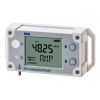HOBO Self-Describing Temperature Sensor
The Onset self-describing air/water/soil temperature sensor is for use with HOBO MX1104 and MX1105 Multi-Channel Data Loggers.
Features
- Various cable lengths available
- Measurement range of -40° and 100°C
- Expedited repair and warranty service
- Lifetime technical support
- More
Overview
The Onset self-describing air/water/soil temperature sensor is for use with HOBO MX1104 and MX1105 Multi-Channel Data Loggers. Thes sensors offer integrated strain relief, so the probe is secured to the logger and features self-describing technology to automatically communicate configuration information to the logger, without any programming or extensive user setup.
- Measurement Range: -40° to 50°C (-40° to 122°F) in water; -40° to 100°C (-40° to 212°F) in air
- Accuracy: ±0.15°C from 0° to 50°C (±0.27°F from 32° to 122°F), insert probe 2.3 cm (0.9 inches) minimum; see Plot A
- Resolution: 0.002° at 25°C (0.003° at 77°F)
- Drift: <0.1°C (<0.2°F) per year
- Response Time in Air: 2 minutes typical to 90% in air moving 1 m/s (2.2 mph)
- Response Time in Stirred Water: 30 seconds typical to 90%
- Operating Range: Sensor tip and cable immersion in fresh water up to 50°C (122°F) for 1 year
- Probe Housing: Copper-plated sensor tip
- Probe Dimensions: 5.1 x 33 mm (0.2 x 1.3 inches)
Cable Lengths:
SD-TEMP-01: 0.3 m (1 ft)
SD-TEMP-06: 1.8 m (6 ft)
SD-TEMP-20: 5.1 m (20 ft)
SD-TEMP-50: 15.2 m (50 ft)
In The News
From Hurricanes to Florida’s Red Tides: Monitoring the Southwest Gulf Coast
Nearly every year, southwest Florida is blighted by harmful Karenia brevis blooms–known colloquially as Florida red tides. These harmful algal blooms (HABs) form over the West Florida shelf and are pushed shorewards by winds and currents. Once in touching distance of the coast, they often intensify, fed by land-based runoff, anthropogenic nutrients, and decomposing marine life killed by toxins produced by these red tides. Red tides have become more severe and persistent over the past 20 years, causing major environmental and economic damage.
Read MoreWave-Powered Buoy Deployed in Puget Sound
While the development of solar-powered monitoring systems has improved access to real-time environmental data, solar power is still limited by low light conditions, such as poor weather, nighttime, or high-latitude environments. To supplement these incumbent power solutions at sea, Ocean Motion Technologies has developed a small-scale ocean wave energy system that can be directly integrated with existing data buoy platforms. Not only does wave energy supplement solar power during periods when the buoys are limited by light availability, but it also allows data buoys to perform beyond their current power capacities.
Read MoreLong-Term Monitoring in the Chautauqua Lake Watershed
With a widely developed shoreline, Chautauqua Lake experiences influxes of non-point source pollution that have historically impacted the health of the lake. The Chautauqua Lake Association (CLA) has been monitoring the lake for over two decades, reporting on changes that have occurred over the years. A pair of local lake advocates, Jane and Doug Conroe, have lived on the lake for over 40 years and have played an important role in establishing monitoring programs and facilitating consistent data collection throughout the watershed. Doug has been involved with the Chautauqua Lake Association (CLA) since the pair moved to the area in 1980, and is currently serving as the Executive Director.
Read More












